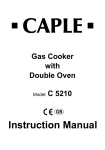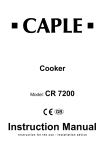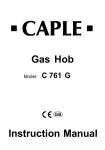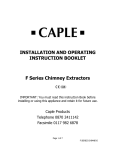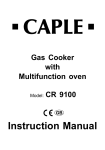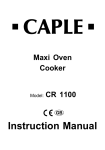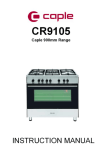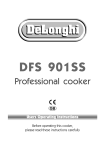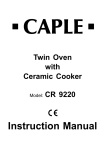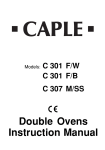Download Caple C 5220 Instruction manual
Transcript
Ceramic Cooker with Double Oven Model: C 5220 Instruction Manual Thank you for buying your new CAPLE Cooker. To ensure that you get the best results from your new CAPLE Cooker, we strongly suggest that you read this instruction manual thoroughly before use. This manual contains installation advice, cleaning tips and a cooking guide, as well as other important facts about your CAPLE cooker. If treated with care, your CAPLE appliance should give you years of trouble-free cooking. For Spare Parts, Technical Advice or Product Service call the CAPLE HELPLINE on 0870 241 1142 (Answerphone outside office hours) The CE marking confirms that the appliance conforms to the following EU directives: - safety requirements of EEC Directive “Low voltage” 73/23; - protection requirements of EEC Directive “EMC” 89/336; - requirements of EEC Directive 93/68. 2 Safety Reminders Instruction Book The Grill and Top oven element This appliance should only be used for it’s intended purpose as described in these instructions. Ensure that you fully understand these instructions before operating this appliance. are exposed, so take great care when placing food in the oven or removing it. Use the grill pan handles or gloves. DO NOT line the oven, grids, trays etc. with aluminium foil as this could adversely affect the heating elements and it could also damage the interior surfaces. Space Requirements Ensure that the specified ventilation space around the appliance is not obstructed. DO NOT place flammable materials in the oven. Faults Food Splashes Always wipe clean the oven after use. Food splashes can carry on cooking next time and may become a fire hazard. Hot Surfaces It is important to remember that the surfaces of cooking appliances get hot during use and retain the heat for some time after switching off. It is therefore advisable to keep small children away from the appliance. Do not continue to use this appliance if it appears to be faulty. After Use Switch the appliance controls off. Always switch off at the isolating switch before cleaning the appliance, or attempting any maintenance task, or when not in use for long periods (when on holiday). CAPLE Service To ensure the continued safe and efficient operation of this appliance, we recommend that any servicing or repairs are carried out only by an authorised CAPLE SERVICE ENGINEER. 3 Electrical Requirements IMPORTANT: The appliance must be installed in accordance with the manufacturer’s instructions. Incorrect installation, for which the manufacturer accepts no responsibility, may cause damage to persons, animals and things. N.B. For connection to the mains, do not use adapters, reducers or branching devices as they can cause overheating and burning. If the installation requires alterations to the domestic electrical system call an expert. He should also check that the socket cable section is suitable for the power absorbed by the appliance. General – Connection to the mains must be carried out by qualified personnel in accordance with current regulations. – The appliance must be connected to the mains checking that the voltage corresponds to the value given in the rating plate and that the electrical cable sections can withstand the load specified on the plate. – The cooker can be connected directly to the mains placing an omnipolar switch with minimum opening between the contacts of 3 mm between the appliance and the mains. – The power supply cable must not touch the hot parts and must be positioned so that it does not exceed 75°C at any point. – Once the cooker has been installed, the switch or socket must always be accessible. 4 IMPORTANT: this cooker must be connected to a suitable double pole control unit adjacent to the cooker. WARNING! This appliance must be earthed. 1 - Electrical Installation - Wall box connection Connecting the mains cable Technical data – Remove the two screws securing the cover plate A behind the cooker. – Remove the screw C from the cable clamp. – Insert the mains cable (type H05RRF) of minimum 6 mm2 section into the cable protector P. – Connect the phase and earth cables to the mains terminal connection block B. 230 V AC - 50 Hz N L Top conventional oven – Top element – Bottom element – Grill element EARTH NEUTRAL LIVE – Refit the cable clamp so that it clamps the outer sleeving of the cable. – Refit the cover plate A. IMPORTANT: This appliance must be earthed. 0.700 kW 1.100 kW 2.100 kW Bottom fan oven – Fan element 2.5 kW Vitroceramic hob – Front left – Back left – Back right – Front right 1.7 kW 1.2 kW 2.2 kW 1.2 kW Maximum power rating – Top oven – Bottom oven 2.1 kW 2.5 kW Oven lamp 0.015 kW 300 °C, miniature edison screw Fan motor Maximum power usable simultaneusly B 0.025 kW 10.96 kW Green &Yellow (Earth) L N Brown (Live) C A Blue (Neutral) Fig. 1.1 P 5 FOR THE INSTALLER 2 - Location The cooker must be installed by a qualified technician and in compliance with local safety standards. The appliance afford type “X” protection against overheating of surrounding surfaces. The appliance must be kept no less than 300 mm away from any side wall which exceed the height of the cooktop (fig. 2.1). 450 mm 650 mm The furniture walls adjacent to the cooker must be made of material resistant to heat. The veneered syntetical material and the glue used must be resistant to a temperature of 120°C in order to avoid ungluing or deformations. The cooker may be located in a kitchen, a kitchen/diner or bed-sitting room but not in a room containing a bath or shower. Curtains must not be fitted immediatly behind appliance or within 500 mm of the sides. It is essential that the cooker is positioned as stated below. Secure the four feet in the holes on the base of the appliance and adjust the height. 300 mm 6 Fig. 2.1 3 - Features and Technical Data Cooking zones (Fig. 3.1) 3 4 1. Radiant hotplate 2. Radiant hotplate 3. Radiant hotplate 4. Halogen hotplate 5. Residual heat indicators 1200 W 1700 W 1200 W 2200 W Attention: Detach the appliance from the mains if the ceramic hobs is cracked. 5 1 2 Ø 145, Ø 180, Ø 145, Ø 210, Fig. 3.1 9 Fig. 3.2 8 7 11 10 6 5 3 4 2 1 Control panel Pilot lamps: Controls description 9. Conventional top oven temperature 10. Main oven temperature 11. Hotplates 1. 2. 3. 4. 5. 6. 7. 8. Front right hotplate control knob Rear right hotplate control knob Rear left hotplate control knob Front left hotplate control knob Main oven switch and thermostat knob Conventional top oven function selector knob Conventional top oven thermostat knob Electronic clock/end cooker timer (main oven only) 7 How To Use the Hotplates The ceramic surface of the hob allows a fast transmission of heat in the vertical direction, from the heating elements underneath the ceramic glass to the pans set upon it. The heat does not spread in the horizontal direction, so that the glass stays “cool” at only a few centimeters from the cooking plate. The 4 cooking plates are shown by dark disks on the ceramic surface. Type of hotplates Halogen hotplate (fig. 3.3). Incorporating 1 halogen lamp and 2 heating elements (fig. 3.3 - type A or B). Instantly reaches the working temperature. Controlled by energy regulator switch. Radiant hotplate Incorporating 3 heating elements you can control and light up all together or separately by a 6 position switch. Reaches the working temperature in a very short time. Type A 8 Type B Fig. 3.3 Radiant hotplate control knob Halogen hotplate control knob The radiant hotplates are controlled by a 6-position control switch (fig. 3.4). The halogen hotplate is controlled by a energy regulator switch (fig. 3.5). The heat power of the halogen hotplate can be adjusted within steps from “0” to its max “12”. Fig. 3.4 Fig. 3.5 9 Cooking plate controlled by a 6 position switch Cooking plate controlled by a 12 position switch Quick-light star hotplates Halogen hotplate 1 1 Cooking hints Position of switch TYPE OF COOKING 0 0 Switched OFF 1 2 1 2 For melting operations (butter, chocolate). 2 2 3 4 To maintain food hot and to heat small quantities of liquid (sauces, eggs). 3 4 5 6 To heat bigger quantities; to whip creams and sauces. (vegetables, fruits, soups). 3 4 6 7 Slow boiling, i.e.: boiled meats, spaghetti, soups, continuations of steam cooking of roasts, stews, potatoes. 4 7 8 For every kind of frying, cutlets, uncovered cooking, i.e.: risotto. 4 5 8 9 10 Browning of meats, roasted potatoes, fried fish, omelettes, and for boiling large quantities of water. 6 11 12 Fast frying, grilled steaks, etc. 2 3 2 4 5 3 6 7 4 8 9 5 10 11 6 12 Heating Cooking Roasting-frying 10 Fig. 3.6 After a short period of use, experience will teach you which setting is the right one for your needs. Residual heat indicator The hob also features 5 warning lamps which are wired to the corresponding plate. When the temperature of a cooking plate is over 60°C, the relevant warning lamp is also lit-up to warn of heat on the surface of the hob. This lamp also stay on after the cooking plate has been switched off to shown that the hob surface is still hot. This residual heat lasts for a rather long time after the cooking plate has been switched off. During this period of time you should avoid touching the hob surface over the cooking area. Please pay special attention to ensuring children are not allowed near the hob. The lamp will switch off automatically as soon as the surface temperature of the cooking plate falls below 60°C. Cooking hints: – To reduce the cooking time, you can turn the control knob to the max when you switch the plate on. After a short time you will set the control knob to the required position for the cooking. – You should use pots and pans with flat bases (pans with the test mark for glass-ceramic hobs are available from specialist shops). The diameter of the pan should match that of the cooking plate (or be slightly bigger) to make the most of the energy. – Since the cooking surface stays hot for a certain time after the plate has been switched off, you can switch it off 5 or 10 minutes before the end of the cooking. The residual heat of the hob will complete the cooking. – To save electricity, use pan lids whenever possible. – Never cook the food directly on the glass ceramic cooktop, but in special pans or containers. Caution! the cooking hob becomes very hot during operation. Keep children well out of reach. Fig. 3.7 11 12 Safety hints: Cleaning – Before you switch the hob on, make sure you know which knob controls the required cooking plate. We advise you to set the pan over the cooking plate before switching it on. Remove the pan after you have switched the cooking plate off. – Do not use pots and pans with rough bases (pay attention to cookware made of cast-iron). Rough bases can damage (scratch) the glass surface of the hob. Make sure that the pan bottom of the pan is dry and clean. – Pots with aluminium bottoms may leave silver streaks or spots on the hob. – Do not leave wet or damp lids on the hob. – The glass-ceramic surface and pans must be clean. Carefully remove any food debris (especially containing sugar), dirt etc. with the aid of a cleansing agent. – Pan handles should never stand out beyond the kitchen worktop, as there is a great danger of knocking the pan over. This will also ensure that children cannot reach them. – Do not use the hob if the glass surface is broken or cracked in any way. Please disconnect the hob from the mains and contact the after-sales service. – Do not lean over the cooking plate when in use. – Do not lay cooking foil or plastic materials on the ceramic surface when it is hot. – Remember that the surface remains hot for a long time (about 30 min.) after the cooking plate has been switched off. – Follow the cleaning instructions carefully. – Do not stare at the light of the halogen hotplate. Before you begin cleaning make sure that the appliance is switched off. Do not use the glass surface for storage. Remove spillages and other types of incrustations. Dust or food particles can be removed with a damp cloth. If you use a detergent, please make sure that it is not abrasive or scouring. Abrasive or scouring powders can damage the glass surface of the hob. All traces of the cleaner must be removed with a damp cloth. Do not put articles on the hob which can melt: i.e plastic, aluminium foil, sugar, sugar syrup mixtures etc. If any of these products items have melted on the ceramic surface, you should remove it immediately (when the surface is still hot) by using a scraper to avoid any permanent damage to the surface of the hob. Avoid using a knife or other sharp utensils since these can damage the ceramic. Do not use steel wool or an abrasive sponge which could scratch the surface permanently. ATTENTION: MOST IMPORTANT! If cleaning the glass ceramic hob using a special scraper tool take extra care to avoid damaging to the seal at the edges of the glass ceramic surface. Fig. 3.8 4 - Electronic clock / end cooking timer The electronic programmer is a device with the following functions: – 24 hours clock with illuminated display – Timing of oven cooking with automatic switch-off (max. 99 minutes). Electronic clock Upon immediate connection of the oven or after a mains failure, three zeros will flash on the programmer panel. To set the clock it is necessary to push the button and then, within 7 seconds, the or button until you have set the correct time. The clock will show zero after a mains failure. Attention: When the programmer display shows three flashing zeros the oven cannot be switched on. The oven can be switched on when the symbol is shown in the display. Setting the frequency of the alarm sound The selection from 3 possibilities of sound can be made by pressing the button. A U T O Fig. 4.1 Cooking with automatic switch-off The aim of this function is to automatically stop the cooking after a pre programmed time, for a maximum period of 99 minutes. To set the cooking time, push the or button until you obtain the desired time in the display. The symbol AUTO will be shown in the display. Then you adjust the oven thermostat knob according to the required temperature. The oven will immediately start to operate and will work for the pre programmed time. The display shows the count down. Clock time can be displayed by pressing the button. Once the time has elasped, the oven will switch off automatically, the symbol AUTO will go off and an intermittent buzzer, lasting 7 minutes, will start; this can be stopped by pressing the buttons. Important: Before the buzzer is stopped switch off the oven manually. To cancel the cooking program at any time press the and buttons together and release the button first. Electronic alarm The programmer can be used as an alarm only for a maximum period of 99 minutes. To set the alarm, push the or button until you obtain the desired time in the display. Once the time has elasped, an intermittent buzzer, lasting 7 minutes, will start; this can be stopped by pressing the button. Attention: If the bottom oven is switched on when the buzzer starts, it will be automatically switched off. For it to operate furtherly you have to stop the buzzer by pressing the button. 13 5 - How To Use the Top Conventional oven Attention: the oven door becomes very hot during operation. Keep children away. WARNING: The door is hot, use the handle. General features As the name implies, this oven features a number of special characteristics from the functional point of view. 2 different thermostatic control functions are available to satisfy all cooking requirements, provided by 3 heating elements: – Top element – Bottom element – Grill element 700 W 1100 W 2100 W OPERATING PRINCIPLES Heating and cooking in the conventional oven are obtained: a. by natural convection The heat is produced by the upper and lower heating elements. b. by radiation The heat is radiated by the infrared grill resistance. NOTE: When using for the first time, you are advised to run the oven at maximum temperature (thermostat knob set to 225) for approximately one hour in the mode and for another 15 minutes in the mode in order to eliminate any traces of grease from the electrical resistances. Fig. 5.1 14 Fig. 5.2 Thermostat knob (Fig. 5.1) This only sets the cooking temperature but does not switch the oven on. Rotate clockwise until the required temperature is reached (from 50 to 225 °C). The light above the knob will illuminate when the oven is swiched on and turns off when the oven reaches the correct temperature. The light will cycle on and off during cooking in line with the oven temperature. Function selector knob (fig. 5.2) Rotate the knob clockwise to set the oven for one of the functions described. Grilling The infrared electrical resistance comes on. The heat is diffused by radiation. Use with the oven door closed and the thermostat knob to 200°C. For cooking hints, see the chapter “USE OF THE GRILL”. Recommended for: Intense grilling, browning, cooking au gratin and toasting etc. Note: It is recommended that you do not grill for longer than 30 minutes at any one time. Attention: the oven door becomes very hot during operation. Keep children away. Oven light By turning the knob onto this setting (see picture aside) we light the oven cavity (15 W). The oven remains alight while any of the functions is on. Use of the grill Traditional convection cooking The upper and lower heating elements come on. The heat is dispersed by natural convection and the temperature must be set to between 50° and 225°C via the thermostat knob. The oven must be preheated before cooking. Recommended for: Food that requires the same degree of cooking both inside and out, for example roasts, spare pork ribs, meringues etc. Leave to warm up for approximately 5 minutes with the door closed. Place the food inside positioning the rack as near as possible to the grill. Insert the drip pan under the rack to collect the cooking juices. Grilling with the oven door closed. Do not grill for longer than 30 minutes at any one time. Attention: the oven door becomes very hot during operation. Keep children away. 15 6 - How To Use the Bottom Main oven Attention: the oven door becomes very hot during operation. Keep children away. Switch and thermostat selector (Fig. 6.1) Turn the selector knob (fig. 6.1) to the required function. OFF as per fig. 6.1 The oven light is switched on. The fan operates without the heating element, this function can be used for defrosting. 50-225 The oven light is switched on. The oven temperature can be set between 50°C 225°C. The set temperature has been reached when the temperature indicator light goes off. Several different meals may be cooked simultaneously on various shelves, as the heated air circulates evenly throughout the oven. The hot air system cooks more quickly than conventional static system, therefore the temperature should be set 15°C 20°C below the values recommended in your recipe books. The oven door may be opened briefly while cooking as any heat losses are quickly recovered when the door is closed. WARNING: The door is hot use the handle. 16 Fig. 6.1 Cooking with air forced Fan cooking is more economical and quicker than cooking in a conventional oven. The moving hot air surrounds the food and penetrates it more quickly than in a conventional oven. The oven can be filled with different dishes all requiring the same cooking temperature. Subtract 10 minutes per hour for every dish requiring a cooking time of more than 1 hour and reduce the heat by 10-20°C; the hotter the oven, the more the temperature can be reduced. Generally, there is no need to pre-heat the oven, but it is advisable to pre-heat for about 5 minutes to ensure the best results; use the indicator light as a guide, it goes out when the set temperature is reached. Fan cooking is ideal for gelatine based dishes and softening ice cream - a microwave oven is much too strong for these dishes. Cooking yeast based dishes is also speeded up this way. If the oven door has been opened, the oven quickly regains its temperature once the door is closed. 17 Recommended cooking temperature Food °C °F Gas Mark Shelf Position* Cooking Time (approx) CAKES Victoria sandwich Small cakes/buns Maidera cake Fruit cake Rich fruit cake Scones 190 190 180 170 150 225 375 375 350 325 300 425 5 5 4 3 2 8-9 2 or 3 1 and 2 2 or 3 3 3 or 4 2 20-25 mins 15-20 mins 20 mins 13/4 hours 21/2 hours 8-10 mins PASTRY Puff Short crust Plate tarts Quiches and flans 225 200 200-210 200-210 425 400 400-410 400-410 8-9 6 6 6 2 2 1 or 2 1 or 2 10-20 mins 20-30 mins 30-35 mins 40-45 mins 225 220 230 425 425 450 7-8 7 8 2 1 or 2 2 35-55 mins 15-20 mins 20 mins 190 190 190-200 190 190 180 150-170 375 375 375-400 375 375 350 300-325 5 5 5-7 5 5 4 2-3 2 or 3 2 or 3 2 or 3 2 or 3 2 or 3 2 or 3 2 or 3 20 mins/lb + 20 mins 25-30 mins/b + 25 mins 30 mins/lb + 30 mins 30 mins/b + 30 mins 30 mins/b + 30 mins 18-20 mins/b + 20 mins 11/2 2 hours YEAST Bread loaf Bread rolls Pizza dough ROAST MEAT Beef – Medium Lamb Pork Veal Chicken Turkey up to 10lb Stews/casseroles N.B. For fan ovens reduce the temperature by 10-20°C. For any dish taking one hour or over to cook, reduce the cooking time by 10 minutes per hour. 18 * Shelf positions have been counted from the top of the oven to the base. A fan oven creates more even temperature throughout, therefore the shelf positions are not as critical. 7 - Cleaning and Maintenance General advice – Important: Before any operation of cleaning and maintenance disconnect the appliance from the electrical network. – It is advisable to clean when the appliance is cold. – Do not use a steam cleaner because the moisture can get into the appliance thus make it unsafe. Cleaning All the enamelled parts must be cleaned with a sponge and soapy water or other non-abrasive products. Dry preferably with a soft cloth. Acidic substances like lemon juice, tomato sauce, vinegar etc. can damage the enamel if left too long. Attention The appliance gets very hot, mainly around the cooking areas. It is very important that children are not left alone in the kitchen when you are cooking. Oven Stainless steel surfaces CAUTION The STAINLESS STEEL front panels on this cooker (facia, oven door, drawer or storage compartment) are protected with a Special Lacquer to reduce finger-print marks. To avoid damaging this lacquer, do not clean the stainless steel with abrasive cleaners or abrasive cloths or scouring pads. ONLY SOAP/WARM WATER MUST BE USED TO CLEAN THE STAINLESS STEEL SURFACES. The oven with smooth enamel must be cleaned after every use, using suitable products and keeping in mind that its operation for 30 minutes on the highest temperature eliminates most grime reducing it to ashes. It is mandatory not to use abrasive substances. Replacing the oven light bulb Switch the cooker off at the mains. When the oven is cool unscrew and replace the bulb with another one resistant to high temperatures (300°C), voltage 230 V (50 Hz), 15 W, E14. Note: Oven bulb replacement is not covered by your guarantee. 19 Using the top and the main oven for the first time You are advised to carry out the following operations: – Clean the inside of the two ovens with a cloth soaked in water and neutral detergent and dry thoroughly. – Hang up the wire racks on the oven walls (Figure 7.1 and 7.2). Fig. 7.1 – Slide in, on the guides, the shelf and the tray etc. (Figure 7.3). The shelf must be fitted so that the safety catch, which stops it sliding out, faces the inside of the oven. – To eliminate traces of grease from the heating elements, switch on the ovens to the maximum temperature. – To dismantle, operate in reverse order. Oven door The internal glass of the oven door can be easily removed for cleaning by unscrewing the two lateral fixing screws (fig. 7.4). Fig. 7.2 20 Fig. 7.3 Attention: Do not store flammable material in the oven. Fig. 7.4 Fig. 7.5A Type A Removing the oven door The oven door can easily be removed as follows: – Open the door to the full extent (fig. 7.5A). – Attach the retaining rings to the hooks on the left and right hinges (fig. 7.5B). Fig. 7.5B – Hold the door as shown in fig. 7.5. – Gently close the door and withdraw the lower hinge pins from their location (fig. 7.5C). – Withdraw the upper hinge pins from their location (fig. 7.5D). – Rest the door on a soft surface. – To replace the door, repeat the above steps in reverse order. Fig. 7.5C Fig. 7.5D Fig. 7.5 21 Type B Dismontling the door Please operate as follows: L – Open the door completely. – Push down the lever “L” and, keeping it in this position, slowly close the door in order to block the hinge. – Grip the door (as indicated in fig. 7.7) and, while closing it, release the two hinges as shown in fig. 7.8. Fig. 7.6 Door assenbly – Grip the door with your hands placed near the hinges and raise the levers “H” with your forefingers (fig. 7.8). – Insert the hinges in their position until levers “H” are hooked. – Open the door completely to obtain the release of levers “L”. Fig. 7.7 H Fig. 7.8 22 Helpful Advice Trouble shooting Problem Food too brown but not cooked. Remedy Turn down the oven temperature slightly and cook a little longer Problem Food cooked but not brown enough. Remedy Increase temperature. Problem Food baking unevenly. Remedy 1. The temperature may be slightly high turn it down 2. Position the food in the centre of the shelves rather than towards the sides of tho oven. 3. Rotate the food a half turn in the oven. 4. Try pre-heating the oven for 5-15 minutes prior to baking. Always remove cooked items as soon as they are ready and continue cooking the under-cooked items until they are completely finished. Changing the Oven Cavity Light Bulb. If the oven light falls: 1. Turn off the oven by switching the oven selector to 0, switch off at the cooker point. 2. When the oven is cool, reach back and upwards inside the oven, the bulb is in the top left corner. 3. Unscrew the light glass cover, replace the bulb with a new one of the same specification and screw the cover back until it is hand tight. NOTE: Oven bulb replacement is not covered by your guarantee. Other bulbs cannot be changed by yourself and should be replaced by an authorised CAPLE Service Engineer. IMPORTANT: Ovens get hot. Keep children away from this appliance at all times. Safety precautions (main oven only) During use the oven door glass becomes hot. In the presence of children, in order to avoid contact with the hot door, a third internal glass should be mounted. This third internal glass is supplied on request as an optional (not included in price). Please contact your retailer or the AfterSales Service, indicating the model bought. If Your Oven Does Not Work Before calling a CAPLE service engineer run through the following checklist. 1. The cooker is connected to the power supply and that the fuse is intact. 2. Make sure the timer control is set to the manual position, and that the oven has not been set inadvertently for an automatic or timed programme. If you are in any doubt about carrying out these checks, call the CAPLE Helpline on 0870 241 1142. A charge will be made if the appliance is found to be in working order, or if it has not been installed in accordance with these instructions, or if it is has been used incorrectly. 23 CAPLE “Built-in” Service Should you require service at any time, please contact the Caple Helpline on 0870 241 1142. Caple have a nationwide service network of engineers who will respond quickly to your call. Always replace spare parts with genuine Caple spares. These are available from authorised Caple Service Centres or by mail order from our National Service Stores, simply telephone 0870 241 1142. When ordering parts always quote the model number and serial number of your appliance. YOUR GUARANTEE CAPLE guarantees all parts of this product for one year from the date of purchase. During that time, should it become necessary CAPLE engineers will replace or repair all defective parts free of charge, except for parts subject to fair wear and tear, such as lightbulbs. Parts and the engineers labour costs are chargeable after the first 12 months. To qualify for benefits under the guarantee, you must be able to provide proof of date of purchase and the appliance must have been supplied, installed and used for domestic purposes only in accordance with CAPLE instructions. Consequential losses and accidental damage to the product are not covered by the guarantee. This guarantee does not affect your statutory or common law rights. ß3 CAPLE cannot be responsible for the results of using this appliance for any other purposes other than those described in these instructions. Cod. 1102100
























